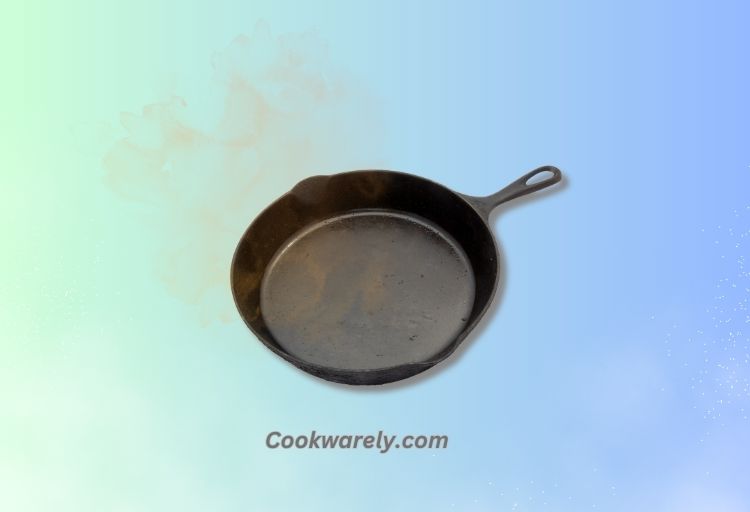How To Reduce Smoke When Cooking With Cast Iron (5 Easy Steps!)
Cooking with a cast iron skillet is a delightful experience, but that joy can quickly turn to frustration when your skillet starts belching smoke, filling your kitchen with an unpleasant haze.
To reduce smoke when cooking with cast iron, use high smoke point oils, heat gradually, and maintain proper ventilation. Keep the skillet clean and well-seasoned for optimal results.
Nobody wants their dinner accompanied by a side of smoke. Also, reducing smoke when cooking with cast iron lies in creating a healthier, more pleasant cooking environment and preserving the quality of your meals.
First, reduce the heat immediately to prevent further smoking. If the smoke is excessive, consider removing the skillet from the heat source temporarily.
Then, pour off any rancid oil, allow the skillet to cool slightly, and wipe out any burnt bits and blackened oil.
Finally, reheat the skillet at a lower temperature, add fresh oil, and resume cooking. This simple adjustment can salvage your meal and prevent further smoke from ruining your culinary experience.
5 Steps to Reduce Smoke When Cooking with Cast Iron
| Steps | Solutions |
|---|---|
| 1. Ensure your cast iron skillet is clean | Clean the skillet thoroughly before each use. |
| 2. Use cooking oils with high smoke points | Choose oils like canola or grapeseed for high heat. |
| 3. Heat the skillet gradually and evenly | Start with medium heat and adjust as needed. |
| 4. Maintain proper ventilation in your kitchen | Use exhaust fans or open windows to remove smoke. |
| 5. Adjust heat and cooking method as needed | Lower the heat or modify your cooking technique. |
Key Takeaways
- Ensure your cast iron skillet is seasoned correctly to prevent smoking during cooking and seasoning.
- Use cooking oils with high smoke points, like canola or grapeseed oil, to reduce smoke when cooking.
- Maintain good kitchen ventilation by using exhaust fans or opening windows to minimize smoke buildup.

Why Is My Cast Iron Skillet Smoking?
Reason 1: Excessive Heat
Cast iron skillets can handle high temperatures, but there’s a limit. When your skillet gets too hot, it can start smoking. The seasoning on cast iron pans consists of thin layers of hardened oil, and excessive heat can cause this oil to smoke.
Reason 2: Low Smoke Point Oils
The choice of cooking oil matters. Oils with low smoke points, like olive oil, can trigger smoking when exposed to high heat. This issue can also arise when cooking foods with fats that have lower smoke points, such as bacon or hamburgers.
Reason 3: Improper Cleaning
Neglecting proper cleaning can lead to sticky layers of oil building up on your skillet. Over time, these sticky residues become harder to clean and start smoking as the pan heats up.
What to Do If Your Skillet Starts Smoking?
If your skillet begins smoking during cooking, it’s essential to act promptly to prevent any unpleasant consequences.
If your skillet starts smoking during cooking:
- Turn down the heat immediately to prevent further smoking.
- If the smoke is excessive, remove the pan from the burner temporarily.
- Carefully pour off any rancid oil and allow the pan to cool a bit.
- Wipe out burnt bits and blackened oil.
- Reheat the pan at a lower temperature, add fresh oil, and continue cooking.
How To Reduce Smoke When Cooking With Cast Iron
Here are the steps on how to prevent cast iron pans from smoking:
Step 1: Thorough Cleaning
The foundation of smoke-free cooking with cast iron is cleanliness.
Follow these steps:
- Clean the skillet thoroughly with hot, soapy water and a soft sponge. Don’t worry; soap won’t harm it unless you resort to harsh scrubbing or abrasive utensils.
- Once clean and dry, inspect for sticky spots, and signs of built-up oil. These spots usually occur when excess oil is repeatedly heated and not cleaned out properly.
Step 2: Selecting the Right Cooking Oil
Choosing the right oil can make a significant difference:
- Opt for cooking oils with high smoke points, such as avocado, peanut, canola, sunflower, or grapeseed oil. These oils can handle the heat without smoking.
- Heat the skillet to a medium temperature for a few minutes. To check if it’s ready, sprinkle a few drops of water on it; sizzling water indicates the skillet is ready. Add the chosen oil and begin cooking.
- Keep a close eye on the skillet and adjust the heat as needed. If smoke appears, lower the burner. Remember, it takes a moment for the skillet to adapt to temperature changes.
Step 3: Adjusting Heat and Cooking
- Always monitor and control the skillet’s heat to prevent smoking. Cast iron retains heat well but can get too hot if left unattended.
Tips on Re-Seasoning Your Cast Iron Skillet
Maintaining your cast iron skillet’s seasoning is crucial for smoke-free cooking. Here’s how to do it:
Quick Re-Seasoning
- After cooking, clean the skillet thoroughly, using hot, soapy water if needed.
- Place the skillet on a medium-low heat burner until completely dry.
- While still warm, apply 1 teaspoon of oil and rub it in with a paper towel.
- Use a fresh paper towel to wipe out excess oil; the pan should look dry, not greasy.
- Allow the pan to cool before storing it in a cool, dry place.
Full Strip & Re-Seasoning
This is necessary when the quick re-seasoning isn’t enough or if restoring an old skillet:
- Remove the current seasoning by running the skillet through the cleaning cycle of your oven (approximately six hours).
- Clean the cast iron thoroughly, scrubbing away all seasoning remnants.
- Select a high-smoke point oil for seasoning, like canola or grapeseed oil.
- Preheat the oven to 25°F hotter than the oil’s smoke point and place the skillet inside until it’s completely dry.
- While warm, rub a teaspoon or two of oil over the entire surface, removing excess oil with a fresh paper towel.
- Bake the skillet upside down for an hour to create a fresh layer of seasoning.
- After deep frying, let the skillet sit overnight at room temperature with frying oil to seal the new seasoning.
- Clean the skillet in hot water with a soft sponge or cloth and store it after drying.
Frequently Asked Questions (FAQs)
Are Cast Iron Fumes Harmful?
The fumes from a smoking cast iron skillet are typically from burning oil. While short, infrequent exposure is unlikely to harm you, it’s best to avoid breathing them whenever possible.
Does Seasoning a Cast Iron Create Smoke?
Not if you season it correctly with a small amount of oil. See below for instructions on how to do this.
How Often Should You Season a Cast Iron Skillet?
Perform a quick re-seasoning after every use if possible. Do a full strip and re-season if the pan is badly rusted or the seasoning becomes patchy.
Is It Possible to Ruin a Cast Iron Skillet?
Not unless you crack it or gouge a hole in it somehow, which is quite rare. The best part about cast iron pans is that you can restore them to near-perfect condition even if the finish is damaged.
How Do You Make a Cast Iron Pan Less Smokey?
To make a cast iron pan less smoky, follow these steps:
- Ensure the pan is clean and well-seasoned.
- Use oils with high smoke points, like canola or grapeseed oil.
- Heat the pan gradually over medium heat to prevent overheating.
- Maintain good kitchen ventilation.
- Adjust the heat and cooking method as needed to minimize smoke, preserving a pleasant cooking experience.
How Do You Limit Smoke When Cooking?
To limit smoke when cooking with cast iron, maintain a clean skillet, use high smoke point oils, heat gradually, ensure proper ventilation, and adjust heat and cooking methods as needed.
Why Is My Cast Iron Smoking When Seasoning?
Cast iron may smoke when seasoning due to excess oil, improper seasoning technique, or leftover residue. Ensure a thin, even layer of oil, proper seasoning process, and thorough cleaning to prevent smoke.
Is Cast Iron Smoke Bad for You?
While short exposure to cast iron smoke is unlikely to harm, it’s best to avoid breathing it as it results from burning oil. Prioritize good ventilation when cooking with cast iron.
Why Is My Cast Iron Smoking in the Oven?
Cast iron may smoke in the oven during seasoning due to excess oil or incomplete drying. Use a minimal amount of oil, ensure thorough drying, and follow proper seasoning techniques to avoid smoke.
Conclusion
Preventing your cast iron skillet from smoking is a matter of maintaining it well, using high smoke point oils, and adjusting the heat as needed.
Keep your skillet clean and enjoy smoke-free cooking adventures. Perform regular re-seasoning to maintain its finish and make it a joy to cook with.
Remember, a well-cared-for cast iron skillet is a kitchen treasure that will last for generations.





